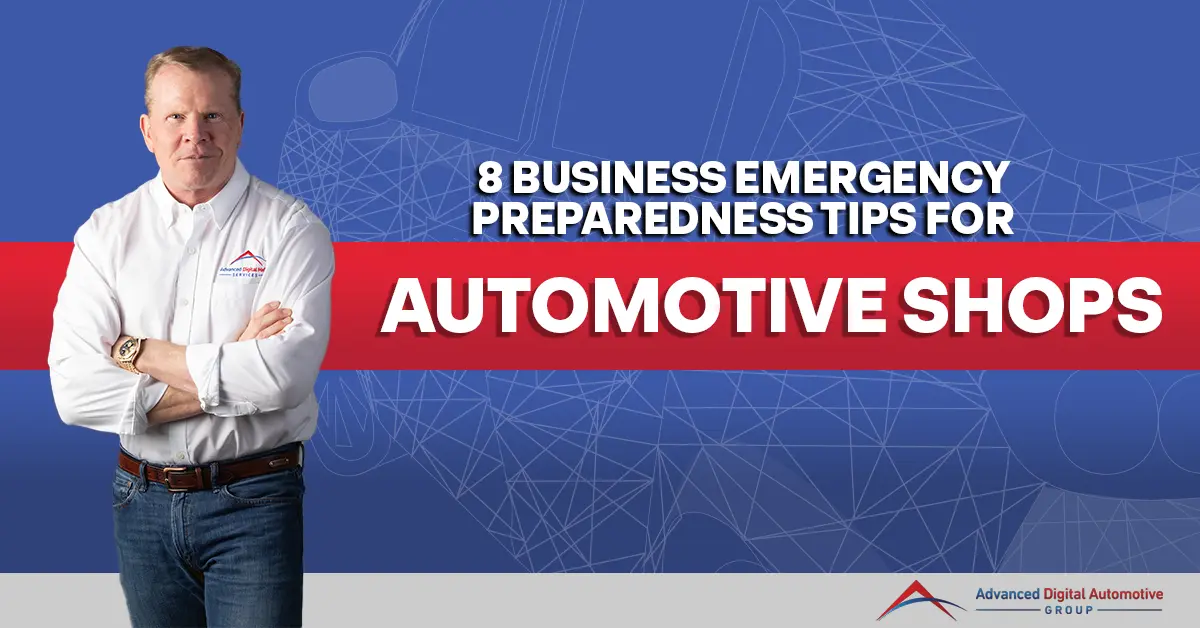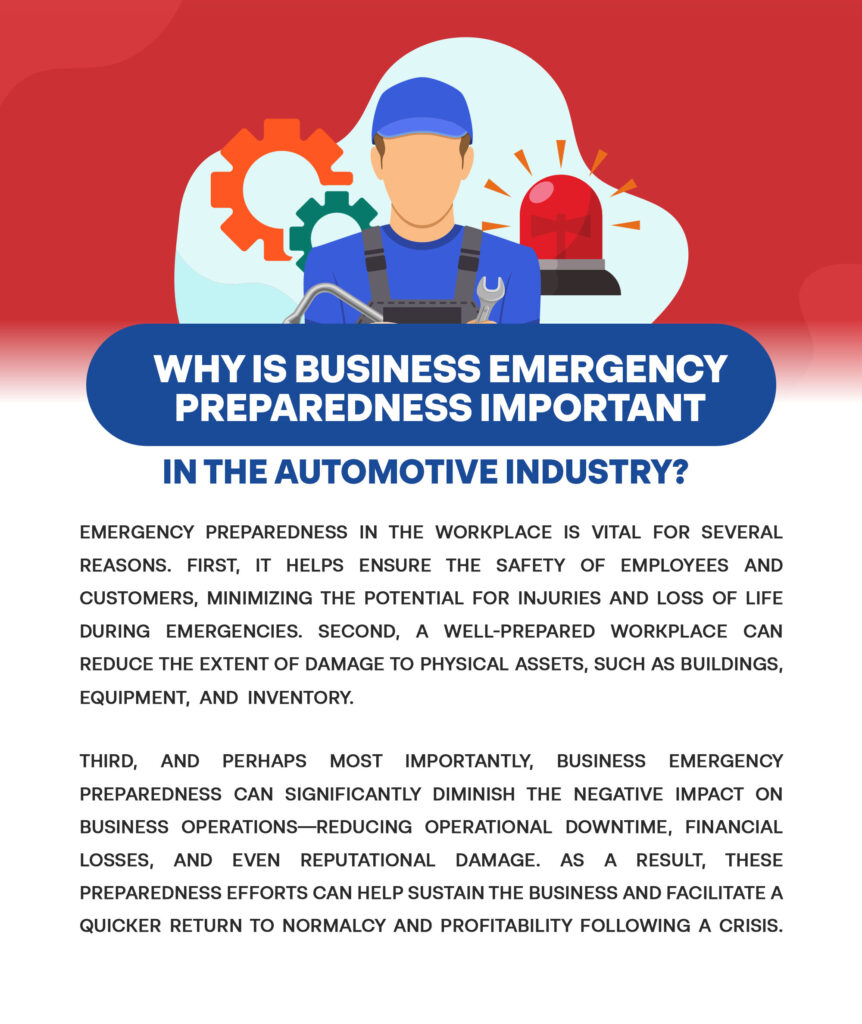An old saying says, “Hope for the best, but prepare for the worst.” This is particularly applicable in business, where uncertainty and unforeseen events can pose significant risks.
A strong focus on business emergency preparedness is crucial for your automotive shop. You never know when disaster might strike—it could be a natural calamity like a hurricane or a sudden fire breakout. You must always have a contingency plan to reduce the impact of such events.
While many businesses recognize the importance of emergency preparedness, not all have taken the necessary steps to safeguard their operations adequately. In this blog, you will learn the best business emergency preparedness tips.
What Is Emergency Preparedness?
Business emergency preparedness refers to the proactive efforts taken by companies to ensure their continuous operation and the safety and well-being of their employees and customers during emergencies. It involves planning, training, and implementing measures to mitigate potential risks and effectively respond to crises.
Emergency preparedness is not a one-size-fits-all concept. Instead, it’s a multifaceted approach designed specifically for a given business’s unique needs and demands. Emergency preparedness in the workplace acts as an umbrella under which various strategies and tools are employed to deal with a wide array of unforeseen events.
From natural disasters such as floods and fires to human-made crises like cyber-attacks or equipment failure, ensuring business continuity by minimizing downtime and financial loss and preserving human life and property should be the goal.
Why Is Business Emergency Preparedness Important in the Automotive Industry?
Emergency preparedness in the workplace is vital for several reasons. First, it helps ensure the safety of employees and customers, minimizing the potential for injuries and loss of life during emergencies. Second, a well-prepared workplace can reduce the extent of damage to physical assets, such as buildings, equipment, and inventory.
Third, and perhaps most importantly, business emergency preparedness can significantly diminish the negative impact on business operations—reducing operational downtime, financial losses, and even reputational damage. As a result, these preparedness efforts can help sustain the business and facilitate a quicker return to normalcy and profitability following a crisis.
Preventive Measures for Achieving Business Continuity
Business continuity is creating systems that allow a business to operate smoothly during and after a disruptive event. To achieve business continuity, you must implement emergency preparedness in the workplace with measures that minimize the impact of the disaster on your business operations. These measures can include the following:
1. Assessing Risks
To ensure stable business emergency preparedness, conducting a thorough risk assessment is crucial to identify potential hazards that could disrupt your operations and the appropriate measures to address them. This can include creating procedures for properly handling and storing hazardous materials, implementing strict safety protocols, and regularly inspecting and maintaining equipment.
2. Developing a Business Continuity Plan
Business emergency preparedness plans outline the actions and procedures to be followed during an emergency to minimize disruption and facilitate a quick recovery. To achieve business continuity, your goal should include:
Emergency Response Planning
Having well-defined protocols for responding to different types of emergencies, such as fires, natural disasters, and accidents, can significantly minimize damage and ensure business continuity. Your plan should cover evacuation procedures, emergency contacts, and assigned responsibilities for key personnel.
Employee Training and Awareness
Preparing employees for emergencies is key to business continuity. Regular training and drills help ensure that your staff is familiar with emergency procedures and can act swiftly and effectively when needed. It’s important to communicate any updates or changes to your emergency preparedness plans and provide clear guidance on individual roles and responsibilities.
Safe Data Storage and Backup
In today’s digital age, safeguarding your business’s data is crucial for ensuring business continuity. Implementing secure data storage and regular backup systems can help protect your valuable information from being lost or compromised during cyber-attacks, natural disasters, and physical damage.
3. Building Maintenance and Inspection
To ensure business continuity in the long term, prioritize your facility’s regular inspection and maintenance. This includes electrical systems, plumbing, and structural components. Promptly addressing any identified issues can help prevent them from escalating into larger problems that could disrupt your operations.
4. Insurance Coverage Review and Update
Insurance is a crucial component of ensuring business continuity. Regularly reviewing and updating your coverage is essential to ensure it protects your business during different emergencies. Be sure to understand the terms and conditions of your policies and consider any additional coverage options relevant to your industry and location.
5. Establishing Alternate Suppliers and Vendors
Having backup suppliers and vendors lined up can be a lifesaver for your business during emergencies that disrupt your usual supply chain. When ensuring business continuity, you need to establish and maintain relationships with alternative suppliers and vendors so you can quickly pivot and secure the resources you need to keep your operations running smoothly.
6. Communication Plan Creation
Effective communication is essential for ensuring business continuity during a crisis. Establishing a clear communication plan outlining internal and external communication methods in different emergency scenarios will minimize confusion and promote swift decision-making. Ensure all employees know the plan and how to use the communication channels.
7. Regular Plan Testing and Review
To ensure the capabilities of your business to continue functioning during an actual disaster, business continuity plans should undergo regular testing and review. These help identify gaps, weaknesses, or changes in your operations and emergency preparedness requirements before an emergency occurs. It is also advisable to learn from past emergencies, whether experienced by your business or others, to enhance your emergency preparedness.
Ensuring an Auto Garage Is Prepared for Any Emergency
Any emergency can disrupt your business and put the safety of your employees and customers at risk. Therefore, it is essential to prioritize emergency preparedness in the workplace to ensure the business continuity of your auto garage. Here are some key steps to consider:
1. Identify Potential Risks Specific to Your Auto Garage
Start by comprehensively assessing the potential risks and hazards specific to your auto garage. Examples are:
- The storage of combustible materials.
- The use of heavy machinery.
- The risk of oil or fuel spills.
Understanding these risks will help you develop targeted emergency preparedness measures.
2. Develop an Emergency Preparedness Plan Tailored to Your Auto Garage
Once you have identified the specific risks, develop a detailed business emergency preparedness plan that outlines the necessary actions to be taken during different types of emergencies. The plan should address key safety considerations, such as evacuation procedures, the use of fire suppression equipment, and protocols for addressing potential leaks or spills.
3. Establish a Designated Emergency Preparedness Team
Assign responsibilities to designated emergency preparedness team members who will take the lead in executing the plan. Their responsibilities may include:
- coordinating evacuation efforts
- managing communication with emergency services
- conducting drills and training sessions to ensure preparedness among your employees.
4. Provide Comprehensive Employee Training
Ensure that all employees receive comprehensive training on the emergency preparedness procedures for your auto garage. This training is crucial for their safety and the safety of others in the event of an emergency. Regularly schedule drills to evaluate the effectiveness of the training and to familiarize employees with the appropriate response actions.
5. Maintain and Regularly Inspect Emergency Preparedness Equipment
Invest in and maintain appropriate emergency preparedness equipment such as fire extinguishers, smoke detectors, and first-aid supplies. Schedule regular inspections and maintenance to ensure their functionality in times of need.
6. Secure Important Documents and Data
Protecting your auto garage’s important documents and data is essential to emergency preparedness. Make backup copies of essential paperwork and store them securely off-site. Implement digital data backup and security measures to safeguard your facility’s customer information and other critical data.
7. Review and Update Insurance Coverage
Regularly review and update your insurance coverage to ensure it adequately addresses the potential risks and hazards specific to your auto garage. Understanding the details of your coverage will help you make informed decisions during major crises.
Regularly reviewing and updating your insurance is vital because the auto industry is constantly changing, bringing new risks for which you might not be covered. This is more than just a box-ticking exercise; it’s a way to protect your business financially, ensuring you’re not out-of-pocket if the worst happens.
Plus, having up-to-date insurance can give you, your employees, and your customers added peace of mind, knowing that you’ve taken another step in ensuring business continuity and safety for all.
8. Establish Relationships With Relevant Emergency Services
Increase the effectiveness of your emergency preparedness efforts by establishing relationships with local emergency services. This will enable you to access timely assistance, such as faster response times and specialized guidance in case of unique risks. Additionally, collaborating with emergency services may provide invaluable information for enhancing your safety measures.
Key Takeaway
Creating a safe environment and maintaining smooth operations are at the heart of every successful auto repair business. To achieve this, integrating business emergency preparedness is essential. Accidents cannot be predicted, but their potential impacts can be mitigated through proper planning and proactive measures.
Effective business emergency preparedness means recognizing potential risks and establishing responsive solutions to minimize the impact of unexpected events. By investing in the safety of both your workforce and the overall business, you demonstrate a commitment to delivering reliable service to your customers.
Remember, emergency readiness is an ongoing process. Regularly evaluate your business emergency response preparedness and conduct training to ensure your team’s preparedness. By doing so, you protect your garage and enhance its reputation for being reliable in times of crisis.
Protect Your Auto Shop’s Future and Online Presence With ADAG!
While ensuring business continuity during emergencies is paramount, investing in advanced digital marketing measures to boost your garage’s presence is also smart. Book a commitment-free appointment with the highly skilled team at Advanced Digital Automotive Group for comprehensive automotive digital marketing solutions!













